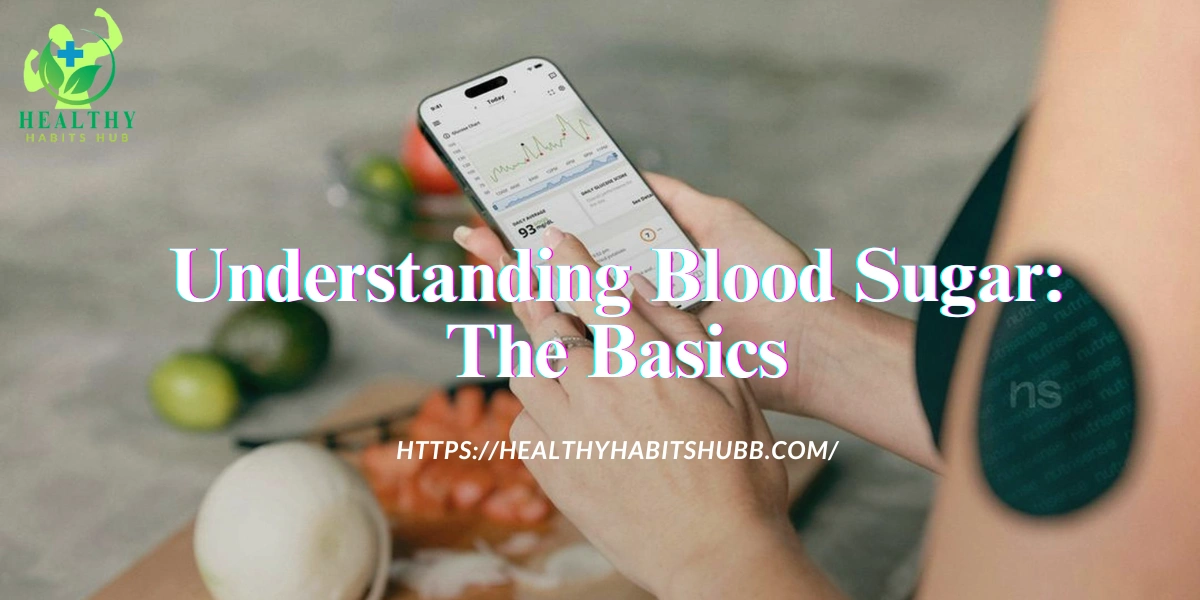Introduction: Why Blood Sugar Matters
Table of Contents
ToggleBlood sugar is the fuels truck that drives energy into every corner of the body. When levels hop on a wild rollercoaster, mood flags, focus drifts, and long-term health may pay the price. Doctors once hoarded the tips, but tweaks like portion control, timing meals, and adding extra movement have slipped out of the clinic and into everyday chat. The tricks feel less like prescriptions and more like common sense once you see the research.
This post, built on studies that arrived before the October 2023 cutoff, catalogs hands-on hacks for anyone from the cautious eater to the person who already wears a glucose monitor. You’re covered whether you’re dodging type 2, managing a diagnosis, or just shoring up a sturdy metabolic wall.
Understanding Blood Sugar: The Basics

What Is Blood Sugar?
Blood sugar is simply the patch of glucose floating around in your blood right now, ready to be spent like pocket change. Carbs tumble into the bloodstream, the pancreas releases insulin, and the hormone shuttles sugar into cells so it can become quick energy. When that rhythm gets out of whack, fatigue, cravings, and later-stage complications knock at the door.
Why Balance Is Key
Swinging too far one way or the other-sugar too high or too low-quickly wipes you out. You feel tired, your thoughts go cloudy, and little things irritate you for no good reason. Keep that up and the long game starts hitting organs and blood vessels in cruel ways. Eventually, doctors label it prediabetes, full-blown type 2 diabetes, or even a nasty heart issue.
The Science Behind Blood Sugar Regulation
How Your Body Regulates Blood Sugar
- Insulin: Lowers blood sugar by helping cells absorb glucose.
- Glucagon: Raises blood sugar by signaling the liver to release stored glucose.
- Other Hormones: Cortisol, adrenaline, and growth hormone also influence blood sugar, especially during stress or fasting.
Factors That Affect Blood Sugar
Food, movement, sleep, anxiety-each one pokes the dial.
- Diet: White bread spikes faster than whole grain, and a late-night snack can mess with overnight numbers.
- Physical Activity: A brisk walk makes cells say, Yes please, to glucose, even long after the sneakers come off.
- Sleep: Tossing and turning robs insulin of its badge, letting sugar float higher than it should.
- Stress: Bills, deadlines, traffic-sustained worry turns the hormone faucet up, lifting the reading for hours.
- Medications and Illness: Steroids, infections, and some other drugs happily upset the apple cart, so doctors keep an extra eye then.
Dietary Tweaks: What to Eat (and When) for Stable Blood Sugar

- Prioritize Fiber-Rich Foods
Swap out white bread for oatmeal. Add a spoonful of flaxseed, barley, or whole-wheat cereal if you can. Soluble fiber slows sugar absorption like a speed bump in the bloodstream.
- Breakfast cookies made with mashed bananas and rolled oats. Snack on apple slices dipped in almond butter. Smoothies blended with kale, spinach, or frozen blueberries keep lunch light but filling.
- A bowl of lentil soup or a chunky chickpea salad pairs perfectly with an end-of-day walk.
Hit a daily target of 25-to-38 grams of fiber and watch smaller glucose jolts become the new normal.
- Pick Low-Glycemic-Carb Heroes
Every food has a speed limit when it comes to raising blood sugar. The glycemic index shows that speed. Sweet potatoes and quinoa sneak in slowly. Most fruits play nice too, with watermelon and pineapple as the lone speedsters.
- Team Up Carbs with Protein or Good Fats
Mixing carbs with protein or healthy fat is like putting the brakes on a sugar rush. Dip apple slices in almond butter, smash avocado on whole-grain toast with a runny egg, or stir berries and chia into Greek yogurt for dessert.
- Size Still Matters
Even the best carbs can overtake your blood stream if the serving plate is oversized. Use smaller dishes, scoop out a measured portion, and check dressings and drinks for secret sugars before you sip.
- Slow Carbs Over Fast Carbs
Slow carbs sit on your plate, not in a factory. They take their sweet time getting digested, and that helps keep blood sugar from bouncing.
- Steel-cut oats: They chew like real food, unlike that instant stuff.
- Brown rice: A bowl of pine-colored pearls is better than snow-white fluff.
- Whole fruit: An apple beats a pour of juice every single time.
- Don’t Skip Meals
Missing breakfast or lunch can send blood sugar on a roller coaster. You end up starving, grab anything handy, and spikes pop up faster than you can blink.
Eat something at regular hours-snack if needed-and stay even.
Mindful Eating: The Missing Link in Blood Sugar Control

What Is Mindful Eating?
Mindful eating is really simple: pay attention. Notice the crunch, feel the hunger, catch the moment when You’re done, and don’t beat yourself up about it.
How Mindful Eating Helps Blood Sugar
- Reduces Overeating: Chew slower and the body shouts, Done! before the plate is empty. No giant spikes.
- Improves Digestion: Calm bites break food into pieces your stomach can handle. Nutrients hitch a smoother ride.
- Decreases Emotional Eating: A quick pause can stop stress snacking and boredom trips to the kitchen.
Mindful Eating Hacks
- Set your fork down after every single bite. Yes, every one.
- Dine in silence. Leave the TV, phone, and computer out of the room.
- Close your eyes for a second and sniff the plate. Feel the crunch, taste the salt, notice how the heat settles on your tongue.
- Scan your belly before the first bite, halfway through, and again when the last morsel disappears. Do you really want more, or are you just bored?
Backed-by-Science Tricks for Blood Sugar Balance
- Walk It Off:
A quick stroll-10, maybe 15 minutes-lets your muscles gobble up the glucose that was just hanging around. - Sleep Deep:
If the blanket is calling, answer it. Good sleep-7 to 9 hours-helps insulin do its job instead of clocking overtime. - Ditch the Drama:
Stress throws cortisol at you, and that hormone loves to elevate blood sugar.- Try taking a slow breath in and an even slower breath out.
- Roll out a yoga mat, or simply roll your shoulders back.
- Jot down what bugs you, then crumple the paper if it makes you smile.
- Head to a park and trade concrete for grass for a while.
- Chug Water:
When your body feels parched, sugar gets stubborn and hangs around. Drink eight cups a day at minimum; pump that number up when the sun is unforgiving or your workout is long. - Limit Alcohol:
Even a couple of drinks can send blood sugar on a rollercoaster ride. The liver first lowers the level, then pumps it back up, usually at the worst possible moment.
If you do sip something stronger, pair it with food and keep the pour light. Appetizer-sized snacks make the glass feel bigger than it really is.
Smart Supplements & Functional Foods
- Cinnamon
Researchers keep circling back to cinnamon. A sprinkle may nudge our cells to listen to insulin, yet the study results swing from promising to iffy.
- Berberine
This plant-derived compound acts almost like prescription drugs for some people. Capsules often cost less than a copay, but they still warrant a doctors thumbs-up.
- Apple Cider Vinegar
Mix a tablespoon with water just before spaghetti or pizza. The sharp tang seems to calm the post-meal blood spike most of us dread.
- Magnesium
A shortage of magnesium quietly sabotages blood sugar control. Dark leafy greens and a handful of nuts may fix the gap, although tablets save time for many.
- Probiotics
Gut bacteria appear to send tidier insulin signals after dinner. Fermented snacks-maybe yogurt, kimchi, or a few bites of sauerkraut can give the microbiome a friendly boost.
Real-World Routines: How to Put It All Together

Nothing beats a game plan you can actually see. This mock day shows how normal meals and small hacks can keep blood sugar in the green zone with little fuss.
Sample Day for Blood Sugar Balance
| Time | Meal/Snack | Blood Sugar Hack |
| 7:00 AM | Breakfast | Oatmeal with berries, chia seeds, and walnuts |
| 10:00 AM | Snack | Apple slices with almond butter |
| 12:30 PM | Lunch | Grilled chicken salad with quinoa and olive oil |
| 3:00 PM | Snack | Greek yogurt with cinnamon and pumpkin seeds |
| 6:30 PM | Dinner | Baked salmon, roasted sweet potatoes, steamed broccoli |
| 8:00 PM | Walk | 15-minute walk after dinner |
| 10:00 PM | Wind-down | Herbal tea, deep breathing, screen-free time |
Blood Sugar Myths vs. Facts
| Myth | Fact |
| Only people with diabetes need to worry | Everyone benefits from stable blood sugar. |
| Fruit is bad for blood sugar | Whole fruit is rich in fiber and nutrients; portion size matters. |
| You should avoid all carbs | Focus on quality and quantity, not elimination. |
| Sugar-free foods are always better | Many contain artificial sweeteners or hidden carbs. |
| Spikes are only caused by sugar | Stress, poor sleep, and inactivity also play big roles. |
Frequently Asked Questions
How often should I check my blood sugar?
People who live with diabetes usually follow a schedule their doctor sets up, so the meter gets a workout most days. Healthy folks don’t need a daily poke; noticing how you feel an hour or two after a meal is often enough to spot bumps in your numbers.
Can I reverse prediabetes with lifestyle changes?
Plenty of studies say yes. Shedding extra pounds, moving your body on a regular basis, and swapping out a few processed snacks for veggies can nudge those borderline readings back to normal.
Is intermittent fasting safe for blood sugar?
Some people notice better insulin response once they spend longer hours away from food, yet the pattern isnt universal. Anyone taking diabetes meds should run the idea by a doctor before skipping breakfast on purpose.
Are there warning signs of blood sugar problems?
Tiredness that wont quit, trips to the bathroom that interrupt everything, a mouth that feels like sandpaper-those red flags deserve a closer look from a healthcare provider. Blurred vision and cuts that heal in slow motion also qualify as alarms.
Advanced Hacks: For Those Who Want to Go Deeper

Try Carb Cycling
This strategy flips the dial on carbs: high one day, low the next. Athletes or people with stubborn insulin resistance sometimes swear by it, though a dietitian or trainer familiar with the plan is wise to have on speed dial.
Experiment with Meal Timing
Some studies hint that eating the bulk of your meals early in the day, a tactic known as front-loading, may keep blood sugar spikes in check. Skipping late-night snacks could lead to steadier energy and mood.
Use a Continuous Glucose Monitor (CGM)
A CGM-the little sensor people stick to their arm-gives a live update on how lunch, stress, or a brisk walk rewires your blood sugar line. Once a diabetic-only tool, the gadget is now turning up at wellness clinics and curious shoppers are renting or buying their own.
Focus on Sleep Quality, Not Just Quantity
Seven or eight hours count for nothing if the sleep is shallow or restless. A cool, dark room plus a tech-free wind-down helps the body hit the deep, reparative stage of snooze that keeps glucose steady.
Build a Support System
Sticking to health goals is easier when someone is in your corner, be it a family member, a workout buddy, or an online group. Shared encouragement and a place to vent stress prove vital for taming blood sugar wiggles.
The Emotional Side of Blood Sugar
Glucose swings leak into feelings, focus, and even how you treat others. One moment you may feel upbeat, the next irritable or foggy. Mindful bites, breathing through pressure, and a bit of self-kindness matter just as much as counting carbs.
Blood-Sugar Heroes: Real People, Real Wins

Shanthi: Turning Fear into Fuel
Shanthi stared at her type-2 diagnosis and felt frozen; the word diabetes seemed to hum on the page. One sleepless night, she swiped every jar of white sugar from her pantry and vowed to fight back. Whole grains, crisp veggies, and colorful fruit moved in, while takeout boxes quietly moved out. Weekends turned into a meal-prep factory, steam rising as she weighed, chopped, and bagged each portion. A short stroll after dinner soon morphed into easy jogs, then muscle-burn workouts that made her laugh at the word cardio. Months slid by and the scale blinked 30 kg lighter, yet the real victory was the bounce in her step and the calm beat of steady blood sugar.
Anand: The Racing Diabetic
Teenage Anand laced up his spikes only to find a syringe sliding into his lunch pack. Running never scared him; balancing insulin with a sprinting schedule did. He studied carbs the way other kids studied comic book plots, jotting numbers in a tiny logbook the at never quit being dog-eared. Race day nerves met a custom meal plan, and somehow the finish flag met a heart already sprinting. One marathon medal became a wall of medals, echoes of his sneakers stamping proof that diabetes shapes goals, not brakes them. Now, he swaps victory laps for talks, underlining that glucose meters belong in the hands of anyone who refuses small horizons.
A Mother and Son’s Team Effort
A few months back, Shanthi thought she was battling diabetes alone, until her son Jai stepped in. He promised to keep her company while swapping chips for carrots. Dinner prep turned into a mini cooking show; they high-fived whenever a new lean recipe passed the taste test. Evening strolls quickly morphed into light jogs, and the living room floor doubled as the cheering section when either of them hit a new milestone. Their home became a lively checkpoint, proving that a buddy who shares the treadmill can sometimes do more than any doctor.
A Cautionary Tale: The Cost of Denial
Across town, another patient rolled the dice and lost. Diagnosed at forty, he brushed off his doctor and kept eating the same fried food, convinced the problem would solve itself. Years later, numb toes gave way to blurred vision and whispering kidney pain; diabetes had taken a long, quiet victory lap. A minestrone finally yanked him awake, sending him straight to rehab with an A1C clocked at 13.6. After that wake-up call, meds, therapy, and a strict meal plan paced his life. The needle is down to 7.2 now, but mail from the pharmacy still lists three medications and warns about dialysis. His story echoes loudly: acting early is cheaper than scrambling later.
Rachel & Cooper: A Family’s Fight with Diabetes
Rachel’s eight-year-old son Cooper woke up one morning with shaky hands and blurry vision. The doctor quickly called it type 1 diabetes. For the next eighteen months, Rachel stared at the clock every few hours, unable to tell if the next beep meant safety or a scary drop in blood sugar. She was drained, frantic, and running out of steam. Everything turned around once Cooper strapped on a small insulin pump. That gadget beeped quietly, measured his blood sugar, and delivered hormone through a plastic tube. Now Rachel can tuck Cooper in at night and actually sleep. Soccer practice is back on the schedule, and the family life they thought was gone has returned.
The story proves two things: smart tech can take mountains off a parents back, and a close-knit community cheering from the sidelines makes a huge difference.
Resources and Further Reading
Conclusion: Your Blood Sugar, Your Power

Keeping blood sugar in check is more of a journey than a finish line. Simple moves-eating with intention, choosing the right foods, staying active, and handling stress-give you command over how you feel each day. Customizing these habits to fit your schedule and preferences makes them stick. So, whether its lunch, a quick walk, or a deep breath, each choice nudges your body closer to balance.
Share your own blood sugar hacks or questions in the comments below. Here’s to steady energy, sharp minds, and vibrant health—one science-backed step at a time!

